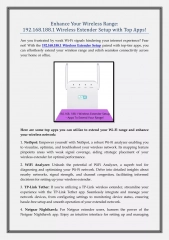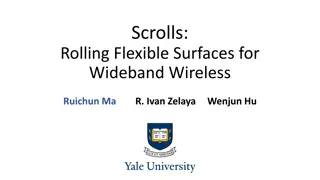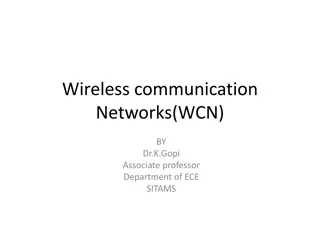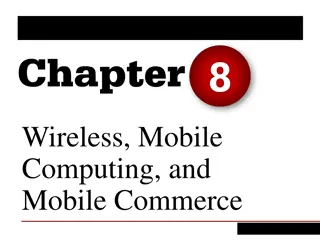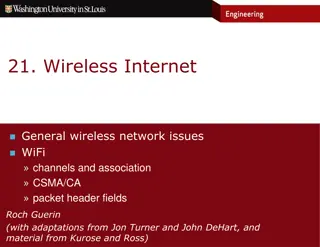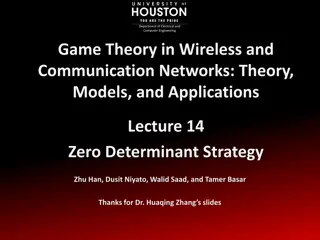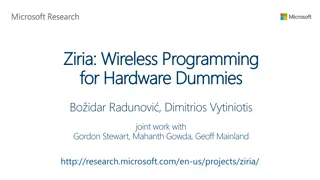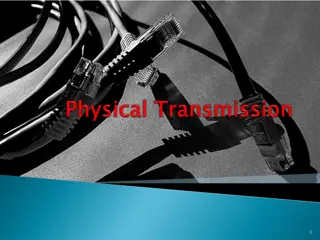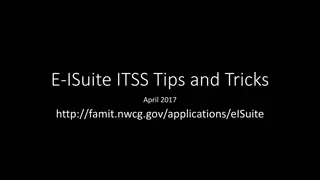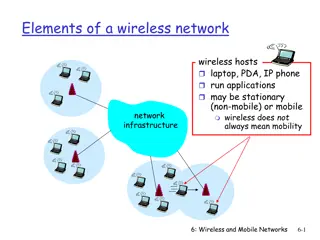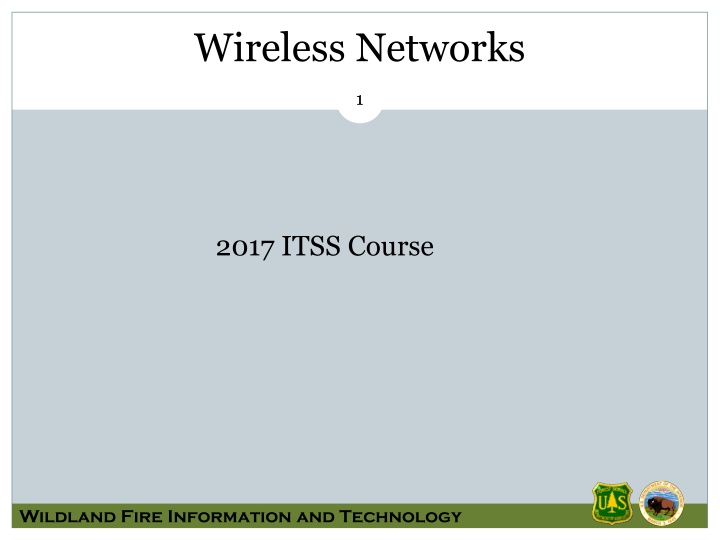
Wireless Networks and Equipment Overview for ITSS Course
Explore the fundamentals of wireless networks, equipment like routers and access points, OSI model, wireless bridges, and wireless clients like laptops and IoT devices. Gain insights into LAN setups, WAN connectivity, and network security features in a campus or office environment.
Download Presentation

Please find below an Image/Link to download the presentation.
The content on the website is provided AS IS for your information and personal use only. It may not be sold, licensed, or shared on other websites without obtaining consent from the author. If you encounter any issues during the download, it is possible that the publisher has removed the file from their server.
You are allowed to download the files provided on this website for personal or commercial use, subject to the condition that they are used lawfully. All files are the property of their respective owners.
The content on the website is provided AS IS for your information and personal use only. It may not be sold, licensed, or shared on other websites without obtaining consent from the author.
E N D
Presentation Transcript
Wireless Networks 1 2017 ITSS Course http://upload.wikimedia.org/wikipedia/commons/thumb/e/e7/US-DeptOfTheInterior-Seal.svg/120px-US-DeptOfTheInterior-Seal.svg.png Wildland Fire Information and Technology
Equipment 2 Wireless Router Access Point Wireless Bridge LAN Switch (higher port density) Wireless Client http://upload.wikimedia.org/wikipedia/commons/thumb/e/e7/US-DeptOfTheInterior-Seal.svg/120px-US-DeptOfTheInterior-Seal.svg.png Wildland Fire Information and Technology
OSI Model 3 http://upload.wikimedia.org/wikipedia/commons/thumb/e/e7/US-DeptOfTheInterior-Seal.svg/120px-US-DeptOfTheInterior-Seal.svg.png Wildland Fire Information and Technology
Wireless Router 4 WAN port Gateway to Internet Service Provider (ISP) DSL modem provided by ISP Dynamic Host Configuration Protocol (DHCP) Limited LAN ports (4 ports is common) Firewall capability http://upload.wikimedia.org/wikipedia/commons/thumb/e/e7/US-DeptOfTheInterior-Seal.svg/120px-US-DeptOfTheInterior-Seal.svg.png Wildland Fire Information and Technology
Access Point 5 One LAN port connection No WAN port (can not connect to ISP) Extends your LAN through the radio spectrum Power over Ethernet (PoE) IEEE 802.11(a, b, g, n, ac) standard http://upload.wikimedia.org/wikipedia/commons/thumb/e/e7/US-DeptOfTheInterior-Seal.svg/120px-US-DeptOfTheInterior-Seal.svg.png Wildland Fire Information and Technology
Wireless Bridge 6 Point to Point implementation that extends one LAN segment to another LAN segment Instead of using cables, Radio waves are used as a conduit Consist of more than one wireless station Layer 2 of the OSI model using MAC addresses Does not see IP addresses, therefore not routable Ex: Connects two adjacent building in a campus http://upload.wikimedia.org/wikipedia/commons/thumb/e/e7/US-DeptOfTheInterior-Seal.svg/120px-US-DeptOfTheInterior-Seal.svg.png Wildland Fire Information and Technology
Wireless Clients 7 Laptops Tablets Mobile Phone Printers and Internet-of-Things (refrigerators, cars, home security system) http://upload.wikimedia.org/wikipedia/commons/thumb/e/e7/US-DeptOfTheInterior-Seal.svg/120px-US-DeptOfTheInterior-Seal.svg.png Wildland Fire Information and Technology
Bridge Pair 8 http://upload.wikimedia.org/wikipedia/commons/thumb/e/e7/US-DeptOfTheInterior-Seal.svg/120px-US-DeptOfTheInterior-Seal.svg.png Wildland Fire Information and Technology
McClellan Dorms APs 9 http://upload.wikimedia.org/wikipedia/commons/thumb/e/e7/US-DeptOfTheInterior-Seal.svg/120px-US-DeptOfTheInterior-Seal.svg.png Wildland Fire Information and Technology
McClellan Dorms Bridges 10 http://upload.wikimedia.org/wikipedia/commons/thumb/e/e7/US-DeptOfTheInterior-Seal.svg/120px-US-DeptOfTheInterior-Seal.svg.png Wildland Fire Information and Technology
802.11a 11 Operates in the 5.15GHz to 5.35GHz radio spectrum. Speed: Up to 54Mbps (actual throughput is closer to 22Mbps) Range: 115 feet indoor Less prone to interference. More expensive. Because 802.11b and 802.11a use different radio technologies and portions of the spectrum, they are incompatible with one another. http://upload.wikimedia.org/wikipedia/commons/thumb/e/e7/US-DeptOfTheInterior-Seal.svg/120px-US-DeptOfTheInterior-Seal.svg.png Wildland Fire Information and Technology
802.11b 12 Operates in the 2.4GHz radio spectrum Speed: Up to 11Mbps Range: 115 feet indoor Prone to interference (it shares airspace with cell phones, Bluetooth, security radios, and other devices). Least expensive wireless LAN specification http://upload.wikimedia.org/wikipedia/commons/thumb/e/e7/US-DeptOfTheInterior-Seal.svg/120px-US-DeptOfTheInterior-Seal.svg.png Wildland Fire Information and Technology
802.11g 13 Operates in the 2.4GHz radio spectrum. Speed: Up to 54Mbps Range: 125 feet indoor Prone to interference (it shares airspace with cell phones, Bluetooth, security radios, and other devices). http://upload.wikimedia.org/wikipedia/commons/thumb/e/e7/US-DeptOfTheInterior-Seal.svg/120px-US-DeptOfTheInterior-Seal.svg.png Wildland Fire Information and Technology
802.11n 14 Operates in the 2.4 or 5GHz radio spectrum Speed: Up to 700Mbs Range: 230 feet indoor Because 802.11b and 802.11g use the same radio technologies and portions of the spectrum, they are compatible with one another. http://upload.wikimedia.org/wikipedia/commons/thumb/e/e7/US-DeptOfTheInterior-Seal.svg/120px-US-DeptOfTheInterior-Seal.svg.png Wildland Fire Information and Technology
802.11ac 15 Bandwidth: Up to 1000 Mb/s (multi-station) or 500 Mb/s (single-station) Range: 115 feet indoor Beamforming (targets clients) Frequency range: 5.0 GHz Multi-user MIMO Spatial Streams http://upload.wikimedia.org/wikipedia/commons/thumb/e/e7/US-DeptOfTheInterior-Seal.svg/120px-US-DeptOfTheInterior-Seal.svg.png Wildland Fire Information and Technology
802.11ac 16 IEEE 802.11n IEEE 802.11ac 2.4 Ghz and 5 Ghz 5 GHz only Frequency Band 20, 40, 80 Mhz 160 Mhz optional 20, 40 Mhz Channel Widths 1 to 8 total Up to 4 per client 1 to 4 Spatial Streams No Yes Multi-user MIMO Single Stream (1x1) Maximum Client Data Rate 150 Mbps 450 Mbps Three Stream (3x3) Maximum Data Rate 450 Mbps 1.3 Gbps http://upload.wikimedia.org/wikipedia/commons/thumb/e/e7/US-DeptOfTheInterior-Seal.svg/120px-US-DeptOfTheInterior-Seal.svg.png Wildland Fire Information and Technology
Exercise 1 - AP Bridge 17 PicoStation2 setup in bridge mode Extend your Cat5 LAN with WLAN IP addresses of your WLAN is in the same broadcast domain as your wired LAN ISP router will provide DHCP and DNS services Try using open network and WEP key for encryption Test all your clients for connectivity http://upload.wikimedia.org/wikipedia/commons/thumb/e/e7/US-DeptOfTheInterior-Seal.svg/120px-US-DeptOfTheInterior-Seal.svg.png Wildland Fire Information and Technology
Exercise 2 - AP as Router 18 PicoStation2 setup in router mode Extend your Cat5 LAN with WLAN but this time create another LAN just for WiFi IP addresses of your WLAN is in a different broadcast domain than your wired LAN Your AP will provide DHCP and DNS services inherited from ISP s router Use WPA2 / AES Test all your clients for connectivity http://upload.wikimedia.org/wikipedia/commons/thumb/e/e7/US-DeptOfTheInterior-Seal.svg/120px-US-DeptOfTheInterior-Seal.svg.png Wildland Fire Information and Technology

